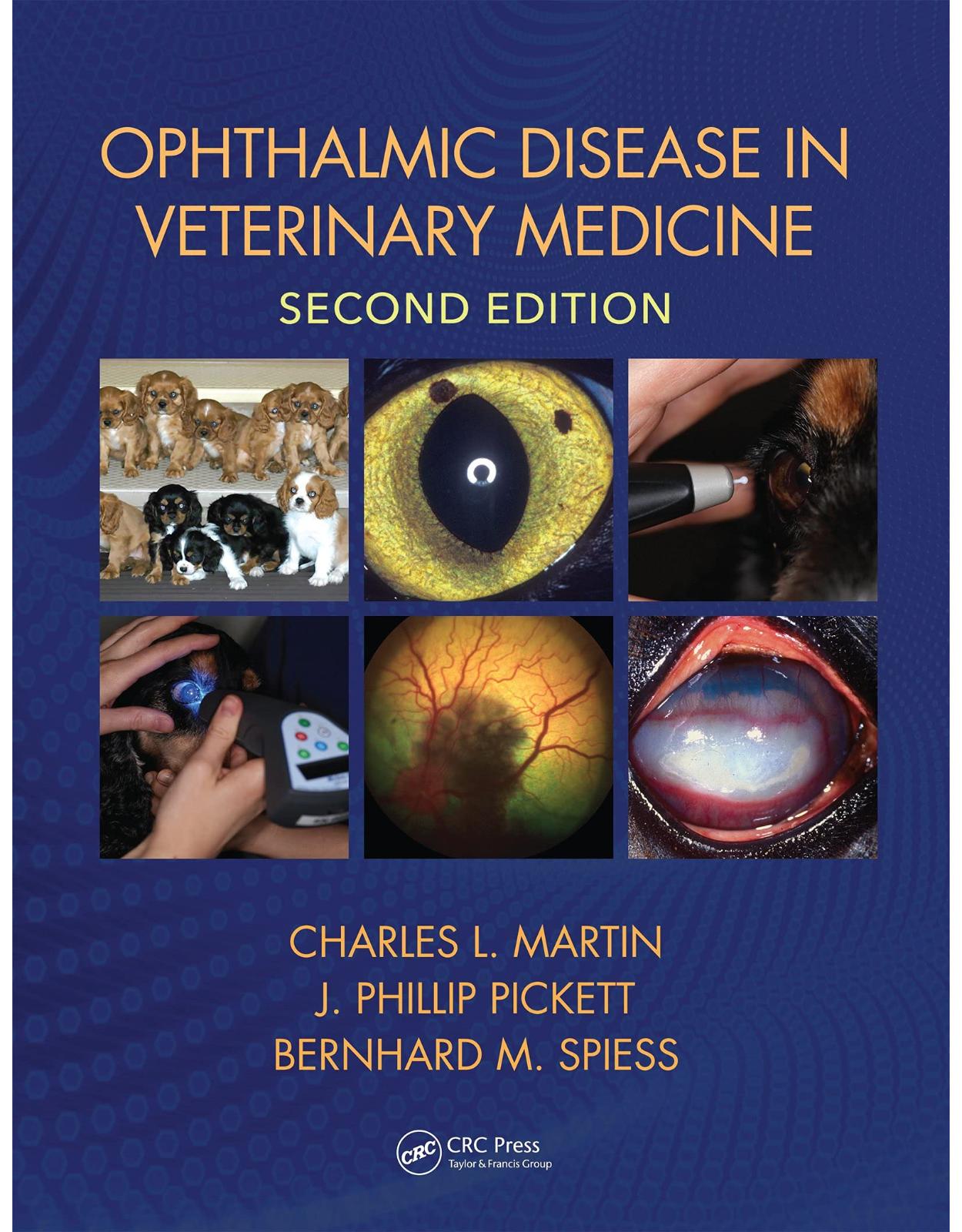
Differential Diagnosis in Small Animal Medicine
Livrare gratis la comenzi peste 500 RON. Pentru celelalte comenzi livrarea este 20 RON.
Disponibilitate: La comanda in aproximativ 4 saptamani
Editura: Wiley
Limba: Engleza
Nr. pagini: 464
Coperta: Paperback
Dimensiuni: 12.7 x 2.54 x 17.53 cm
An aparitie: 2015
DESCRIPTION:
A vital pocket-sized reference tool for busy practitioners and students, saving hours of searching through multiple sources. Differential Diagnosis in Small Animal Medicine, Second Edition brings together comprehensive differential diagnosis lists covering a wide range of presenting signs. This new edition has been fully updated with alphabetised lists for improved navigation. The lists cover the majority of presentations that are encountered in practice, including both common and uncommon conditions.
Details differential diagnoses from diverse findings such as history, physical examination, diagnostic imaging, laboratory test results and electrodiagnostic testing
Provides guidance on how common conditions are, and how commonly they are the cause of the presenting sign
Useful throughout the working day for vets in small animal practice, the information will save hours searching alternative multiple references
New co-author Kate Murphy brings her expertise as an ECVIM diplomate
TABLE OF CONTENTS:
Introduction 1
Part 1: Historical Signs 5
1.1 General, systemic and metabolic historical signs 5
1.1.1 Polyuria/polydipsia 5
1.1.2 Weight loss 7
1.1.3 Weight gain 9
1.1.4 Polyphagia 10
1.1.5 Anorexia/inappetence 11
1.1.6 Failure to grow 13
1.1.7 Syncope/collapse 14
1.1.8 Weakness 18
1.2 Gastrointestinal/abdominal historical signs 22
1.2.1 Ptyalism/salivation/hypersalivation 22
1.2.2 Gagging/retching 24
1.2.3 Dysphagia 26
1.2.4 Regurgitation 27
1.2.5 Vomiting 28
1.2.6 Diarrhoea 34
1.2.7 Melaena 40
1.2.8 Haematemesis 42
1.2.9 Haematochezia 44
1.2.10 Constipation/obstipation 46
1.2.11 Faecal tenesmus/dyschezia 48
1.2.12 Faecal incontinence 49
1.2.13 Flatulence/borborygmus 50
1.3 Cardiorespiratory historical signs 51
1.3.1 Coughing 51
1.3.2 Dyspnoea/tachypnoea 52
1.3.3 Sneezing and nasal discharge 53
1.3.4 Epistaxis 55
1.3.5 Haemoptysis 56
1.3.6 Exercise intolerance 58
1.4 Dermatological historical signs 59
1.4.1 Pruritus 59
1.5 Neurological historical signs 61
1.5.1 Seizures 61
1.5.2 Trembling/shivering 65
1.5.3 Ataxia 67
1.5.4 Paresis/paralysis 76
1.5.5 Coma/stupor 80
1.5.6 Altered behaviour: General changes 82
1.5.7 Altered behaviour: Specific behavioural problems 84
1.5.8 Deafness 85
1.5.9 Multifocal neurological disease 87
1.6 Ocular historical signs 90
1.6.1 Blindness/visual impairment 90
1.6.2 Epiphora/tear overflow 93
1.7 Musculoskeletal historical signs 95
1.7.1 Forelimb lameness 95
1.7.2 Hindlimb lameness 99
1.7.3 Multiple joint/limb lameness 103
1.8 Reproductive historical signs 104
1.8.1 Failure to observe oestrus 104
1.8.2 Irregular seasons 106
1.8.3 Infertility in the female with normal oestrus 107
1.8.4 Male infertility 108
1.8.5 Vaginal/vulval discharge 111
1.8.6 Abortion 111
1.8.7 Dystocia 112
1.8.8 Neonatal mortality 114
1.9 Urological historical signs 115
1.9.1 Pollakiuria/dysuria/stranguria 115
1.9.2 Polyuria/polydipsia 115
1.9.3 Anuria/oliguria 116
1.9.4 Haematuria 117
1.9.5 Urinary incontinence/inappropriate urination 119
Part 2: Physical Signs 121
2.1 General/miscellaneous physical signs 121
2.1.1 Abnormalities of body temperature – hyperthermia 121
2.1.2 Abnormalities of body temperature – hypothermia 127
2.1.3 Enlarged lymph nodes 127
2.1.4 Diffuse pain 130
2.1.5 Peripheral oedema 130
2.1.6 Hypertension 132
2.1.7 Hypotension 133
2.2 Gastrointestinal/abdominal physical signs 135
2.2.1 Oral lesions 135
2.2.2 Abdominal distension 137
2.2.3 Abdominal pain 138
2.2.4 Perianal swelling 141
2.2.5 Jaundice 142
2.2.6 Abnormal liver palpation 144
2.3 Cardiorespiratory physical signs 146
2.3.1 Dyspnoea/tachypnoea 146
2.3.2 Pallor 151
2.3.3 Shock 151
2.3.4 Cyanosis 153
2.3.5 Ascites 155
2.3.6 Abnormal respiratory sounds 155
2.3.7 Abnormal heart sounds 156
2.3.8 Abnormalities in heart rate 160
2.3.9 Jugular distension/hepatojugular reflux 163
2.3.10 Alterations in arterial pulse 163
2.4 Dermatological signs 164
2.4.1 Scaling 164
2.4.2 Pustules and papules (including miliary dermatitis) 166
2.4.3 Nodules 168
2.4.4 Pigmentation disorders (coat or skin) 170
2.4.5 Alopecia 172
2.4.6 Erosive/ulcerative skin disease 174
2.4.7 Otitis externa 176
2.4.8 Pododermatitis 178
2.4.9 Disorders of the claws 180
2.4.10 Anal sac/perianal disease 182
2.5 Neurological signs 183
2.5.1 Abnormal cranial nerve (CN) responses 183
2.5.2 Vestibular disease 186
2.5.3 Horner’s syndrome 189
2.5.4 Hemineglect syndrome (Forebrain dysfunction q.v.) 190
2.5.5 Spinal disorders 190
2.6 Ocular signs 192
2.6.1 Red eye 192
2.6.2 Corneal opacification 197
2.6.3 Corneal ulceration/erosion 198
2.6.4 Lens lesions 200
2.6.5 Retinal lesions 201
2.6.6 Intraocular haemorrhage/hyphaema 203
2.6.7 Abnormal appearance of anterior chamber 204
2.7 Musculoskeletal signs 204
2.7.1 Muscular atrophy or hypertrophy 204
2.7.2 Trismus (‘lockjaw’) 206
2.7.3 Weakness 207
2.8 Urogenital physical signs 207
2.8.1 Kidneys abnormal on palpation 207
2.8.2 Bladder abnormalities 208
2.8.3 Prostate abnormal on palpation 210
2.8.4 Uterus abnormal on palpation 210
2.8.5 Testicular abnormalities 211
2.8.6 Penis abnormalities 211
Part 3: Radiographic and Ultrasonographic Signs 213
3.1 Thoracic radiography 213
3.1.1 Artefactual causes of increased lung opacity 213
3.1.2 Increased bronchial pattern 213
3.1.3 Increased alveolar pattern 214
3.1.4 Increased interstitial pattern 217
3.1.5 Increased vascular pattern 220
3.1.6 Decreased vascular pattern 221
3.1.7 Cardiac diseases that may be associated with a normal cardiac silhouette 222
3.1.8 Increased size of cardiac silhouette 222
3.1.9 Decreased size of cardiac silhouette 223
3.1.10 Abnormalities of the ribs 224
3.1.11 Abnormalities of the oesophagus 225
3.1.12 Abnormalities of the trachea 228
3.1.13 Pleural effusion 230
3.1.14 Pneumothorax 232
3.1.15 Abnormalities of the diaphragm 233
3.1.16 Mediastinal abnormalities 234
3.2 Abdominal radiography 237
3.2.1 Liver 237
3.2.2 Spleen 239
3.2.3 Stomach 241
3.2.4 Intestines 244
3.2.5 Ureters 251
3.2.6 Bladder 251
3.2.7 Urethra 254
3.2.8 Kidneys 255
3.2.9 Loss of intra-abdominal contrast 258
3.2.10 Prostate 260
3.2.11 Uterus 261
3.2.12 Abdominal masses 261
3.2.13 Abdominal calcification/mineral density 262
3.3 Skeletal radiography 264
3.3.1 Fractures 264
3.3.2 Altered shape of the long bones 264
3.3.3 Dwarfism 265
3.3.4 Delayed ossification/growth plate closure 266
3.3.5 Increased radiopacity 266
3.3.6 Periosteal reactions 267
3.3.7 Bony masses 267
3.3.8 Osteopenia 268
3.3.9 Osteolysis 270
3.3.10 Mixed osteolytic/osteogenic lesions 271
3.3.11 Joint changes 271
3.4 Radiography of the head and neck 275
3.4.1 Increased radiopacity/bony proliferation of the maxilla 275
3.4.2 Decreased radiopacity of the maxilla 275
3.4.3 Increased radiopacity/bony proliferation of the mandible 276
3.4.4 Decreased radiopacity of the mandible 276
3.4.5 Increased radiopacity of the tympanic bulla 276
3.4.6 Decreased radiopacity of the nasal cavity 277
3.4.7 Increased radiopacity of the nasal cavity 277
3.4.8 Increased radiopacity of the frontal sinuses 279
3.4.9 Increased radiopacity of the pharynx 279
3.4.10 Thickening of the soft tissues of the head and neck 280
3.4.11 Decreased radiopacity of the soft tissues of the head and neck 281
3.4.12 Increased radiopacity of the soft tissues of the head and neck 281
3.5 Radiography of the spine 282
3.5.1 Normal and congenital variation in vertebral shape and size 282
3.5.2 Acquired variation in vertebral shape and size 283
3.5.3 Changes in vertebral radiopacity 285
3.5.4 Abnormalities in the intervertebral space 286
3.5.5 Contrast radiography of the spine (myelography) 287
3.6 Thoracic ultrasonography 289
3.6.1 Pleural effusion 289
3.6.2 Mediastinal masses 290
3.6.3 Pericardial effusion 290
3.6.4 Altered chamber dimensions 291
3.6.5 Changes in ejection phase indices of left ventricular performance (fractional shortening, FS%; ejection fraction, EF) 294
3.7 Abdominal ultrasonography 294
3.7.1 Renal disease 294
3.7.2 Hepatobiliary disease 297
3.7.3 Splenic disease 300
3.7.4 Pancreatic disease 301
3.7.5 Adrenal disease 302
3.7.6 Urinary bladder disease 302
3.7.7 Gastrointestinal disease 304
3.7.8 Ovarian and uterine disease 305
3.7.9 Prostatic disease 306
3.7.10 Ascites 306
3.8 Ultrasonography of other regions 308
3.8.1 Testes 308
3.8.2 Eyes 309
3.8.3 Neck 311
Part 4: Laboratory Findings 313
4.1 Biochemical findings 313
4.1.1 Albumin 313
4.1.2 Alanine transferase 315
4.1.3 Alkaline phosphatase 316
4.1.4 Ammonia 318
4.1.5 Amylase 319
4.1.6 Aspartate aminotransferase 320
4.1.7 Bilirubin 321
4.1.8 Bile acids/dynamic bile acid test 322
4.1.9 C-reactive protein (D) 322
4.1.10 Cholesterol 323
4.1.11 Creatinine 324
4.1.12 Creatine kinase 324
4.1.13 Ferritin 325
4.1.14 Fibrinogen 326
4.1.15 Folate 326
4.1.16 Fructosamine 327
4.1.17 Gamma-glutamyl transferase 327
4.1.18 Gastrin 328
4.1.19 Globulins 329
4.1.20 Glucose 330
4.1.21 Iron 333
4.1.22 Lactate dehydrogenase 333
4.1.23 Lipase 335
4.1.24 Triglycerides 336
4.1.25 Troponin 337
4.1.26 Trypsin-like immunoreactivity 338
4.1.27 Urea 338
4.1.28 Vitamin B12 (cobalamin) 341
4.1.29 Zinc 341
4.2 Haematological findings 342
4.2.1 Regenerative anaemia 342
4.2.2 Poorly/non-regenerative anaemia 345
4.2.3 Polycythaemia 348
4.2.4 Thrombocytopenia 350
4.2.5 Thrombocytosis 353
4.2.6 Neutrophilia 354
4.2.7 Neutropenia 355
4.2.8 Lymphocytosis 357
4.2.9 Lymphopenia 358
4.2.10 Monocytosis 359
4.2.11 Eosinophilia 360
4.2.12 Eosinopenia 361
4.2.13 Mastocytemia 361
4.2.14 Basophilia 362
4.2.15 Increased buccal mucosal bleeding time (disorders of primary haemostasis) 362
4.2.16 Increased prothrombin time (disorders of extrinsic and common pathways) 363
4.2.17 Increased partial thromboplastin time or activated clotting time (disorders of intrinsic and common pathways) 363
4.2.18 Increased fibrin degradation products 364
4.2.19 Decreased fibrinogen levels 364
4.2.20 Decreased antithrombin III levels 364
4.3 Electrolyte and blood gas findings 365
4.3.1 Total calcium 365
4.3.2 Chloride 367
4.3.3 Magnesium 369
4.3.4 Potassium 371
4.3.5 Phosphate 373
4.3.6 Sodium 375
4.3.7 pH 377
4.3.8 pa02 379
4.3.9 Total C02 381
4.3.10 Bicarbonate 381
4.3.11 Base excess 381
4.4 Urinalysis findings 381
4.4.1 Alterations in specific gravity 381
4.4.2 Abnormalities in urine chemistry 383
4.4.3 Abnormalities in urine sediment 388
4.4.4 Infectious agents 390
4.5 Cytological findings 392
4.5.1 Tracheal/bronchoalveolar lavage 392
4.5.2 Nasal flush cytology 394
4.5.3 Liver cytology 395
4.5.4 Kidney cytology 397
4.5.5 Skin scrapes/hair plucks/tape impressions 398
4.5.6 Cerebrospinal fluid (CSF) analysis 398
4.5.7 Fine-needle aspiration of cutaneous/ subcutaneous masses 400
4.6 Hormones/endocrine testing 401
4.6.1 Thyroxine 401
4.6.2 Parathyroid hormone 403
4.6.3 Cortisol (baseline or post-ACTH stimulation test) 404
4.6.4 Insulin 405
4.6.5 ACTH 405
4.6.6 Vitamin D (1,25-dihydroxycholecalciferol) 405
4.6.7 Testosterone 406
4.6.8 Progesterone 406
4.6.9 Oestradiol 407
4.6.10 Pro-BNP 407
4.7 Faecal analysis findings 408
4.7.1 Faecal blood 408
4.7.2 Faecal parasites 408
4.7.3 Faecal culture 409
4.7.4 Faecal fungal infections 409
4.7.5 Undigested food residues 409
Part 5: Electrodiagnostic Testing 410
5.1 Electrocardiographic findings 410
5.1.1 Alterations in P wave 410
5.1.2 Alterations in QRS complex 411
5.1.3 Alterations in P–R relationship 413
5.1.4 Alterations in S–T segment 414
5.1.5 Alterations in Q–T interval 415
5.1.6 Alterations in T wave 416
5.1.7 Alterations in baseline 416
5.1.8 Rhythm alterations 416
5.1.9 Alterations in rate 420
5.2 Electromyographic findings 422
5.2.1 Spontaneous activity 422
5.2.2 Evoked activity 423
5.3 Nerve conduction velocity findings 423
5.3.1 Decreased velocity 423
5.3.2 Increased velocity 423
Index 424
| An aparitie | 2015 |
| Autor | Alex Gough, Kathryn F. Murphy |
| Dimensiuni | 12.7 x 2.54 x 17.53 cm |
| Editura | Wiley |
| Format | Paperback |
| ISBN | 9781118409688 |
| Limba | Engleza |
| Nr pag | 464 |













Clientii ebookshop.ro nu au adaugat inca opinii pentru acest produs. Fii primul care adauga o parere, folosind formularul de mai jos.